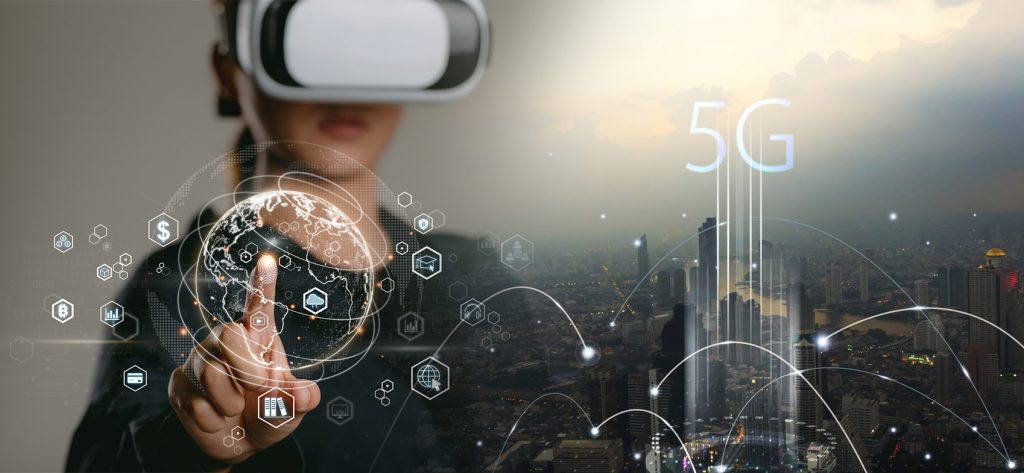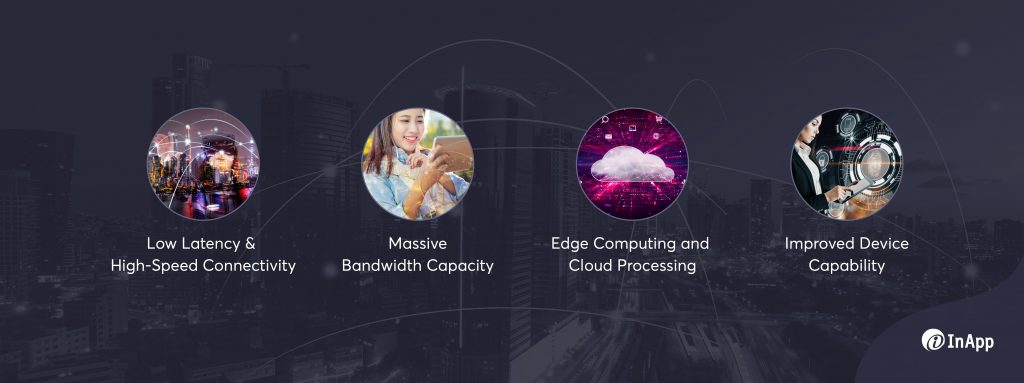The advent of 5G technology is transforming the way we interact with technology, and its impact on Augmented Reality and Virtual Reality (AR/VR) is undeniable. 5G is poised to revolutionize the customer experience by enhancing AR/VR capabilities, making them more accessible and immersive than ever before. This article explores the impact of 5G on AR/VR applications, and how it can benefit businesses in terms of sales, marketing, and customer engagement.
5G and AR/VR: A Match Made in Heaven
AR and VR are immersive technologies that can transform the way we interact with digital content. However, delivering high-quality AR/VR experiences through current mobile networks has been challenging due to limitations in bandwidth, latency, and reliability.

Current mobile networks, such as 4G, struggle to support the high-bandwidth requirements of AR/VR content, resulting in laggy or choppy experiences. In addition, the high latency of current networks can cause delays between a user’s actions and the corresponding response in the AR/VR environment, leading to disorientation and motion sickness. Finally, the reliability of current networks can be inconsistent, resulting in dropped connections or disrupted experiences.
5G is the next generation of mobile networks and offers several benefits for AR/VR. With higher bandwidth and lower latency, 5G can support more immersive and interactive AR/VR experiences. For example, users can stream high-quality VR content without experiencing buffering or lag. In addition, 5G’s increased reliability means users can enjoy consistent and uninterrupted AR/VR experiences.
Breaking Down the 5G Advantage for AR/VR Applications
The potential impact of 5G technology on AR/VR applications is immense. 5G has been hailed as a game-changer for AR/VR, and it’s not hard to see why. The capabilities of 5G — low latency, high-speed connectivity, massive bandwidth capacity, edge computing, and cloud processing — offer unique advantages for AR/VR applications, making them more immersive, interactive, and accessible than ever before.

These key advantages of 5G make it a game-changer for AR/VR.
1. Low Latency & High-Speed Connectivity
5G technology offers low latency, which means that there is minimal delay between the time an AR/VR application sends a signal and when it is received. This low latency, combined with high-speed connectivity, makes AR/VR applications more responsive and seamless, allowing for a more immersive and realistic experience. With 5G, AR/VR applications can deliver real-time experiences without the lag, jitter, or buffering that can detract from the user’s experience.
2. Massive Bandwidth Capacity
5G technology offers a massive bandwidth capacity that can support large amounts of data at once. Bandwidth is particularly important for AR/VR applications, which require significant amounts of data to create immersive experiences. With 5G, AR/VR applications can stream high-quality content seamlessly and without interruption, providing users with a more engaging experience.
3. Edge Computing and Cloud Processing
5G technology is not just about speed and bandwidth. It also offers the capability of edge computing and cloud processing. Edge computing allows for processing data closer to the user, reducing latency and improving the user experience. Cloud processing provides more processing power and storage capacity for AR/VR applications, which can run complex simulations and create immersive environments that were not possible before.
4. Improved Device Capability
With 5G technology, users can access AR/VR applications on a wider range of devices, including smartphones, tablets, and wearable devices. As a result, businesses can create AR/VR experiences that are available to more customers.
Exploring the Limitless Possibilities of 5G-Enabled AR/VR Applications
The combination of 5G and AR/VR technologies is unlocking a wide range of possibilities across various industries. The high bandwidth, low latency, and increased reliability of 5G networks make it possible to create more immersive and interactive AR/VR experiences. Let’s explore some examples of how 5G-powered AR/VR can revolutionize different industries.
Retail
In the retail industry, 5G-powered AR/VR can enhance the shopping experience by allowing customers to try on clothes virtually or visualize how products would look in their homes. With 5G, retailers can offer high-quality, real-time experiences that engage customers and drive sales.
One example of retailers using 5G-powered AR/VR technologies is the Swedish furniture giant IKEA. With its Place app, customers can use their smartphones to virtually place true-to-scale 3D models of IKEA furniture in their homes to see how they fit and look before purchasing. By using 5G, the app can deliver high-quality, real-time 3D models without any lag or delay, allowing customers to get a more accurate and immersive preview of the products they want to buy.
Automotive
In the automotive industry, 5G-enabled AR/VR can transform the way cars are designed, manufactured, and sold. Car manufacturers can use AR/VR to visualize and test new designs, while dealerships can offer virtual test drives and personalized product demonstrations.
For instance, Audi’s “Holoride” system uses 5G connectivity to deliver a fully immersive VR experience to passengers during their car ride. The system tracks the car’s movements and adjusts the VR content accordingly, providing an interactive and dynamic experience that synchronizes with real-world driving conditions.
Healthcare
In the healthcare industry, 5G-powered AR/VR can revolutionize medical training, patient care, and surgery. Surgeons can use AR/VR to practice complex procedures, while medical professionals can use virtual reality to treat patients with phobias, anxiety, and PTSD.
With the help of 5G, medical students and surgeons can access high-quality, real-time 3D models of human anatomy, which they can use to practice surgical procedures and improve their skills. In addition, AR/VR technology can also be used to help patients overcome anxiety and pain by creating a distraction through immersive experiences, such as virtual tours or games.
Education
In the education industry, 5G-powered AR/VR can provide students with immersive and interactive learning experiences. With AR/VR, students can visualize complex concepts, explore historical landmarks, and experience science experiments in a safe and controlled environment.
One example is the use of AR/VR in virtual field trips, which allow students to visit historical sites, museums, and other locations from anywhere in the world. With the help of 5G, students can access high-quality, real-time 3D models of these locations, which they can explore in an immersive and interactive way.
Entertainment
In the entertainment industry, 5G-powered AR/VR can offer users a more immersive and interactive way to engage with movies, music, and live events. With 5G, users can stream high-quality VR content without buffering or lag, creating a more seamless and enjoyable experience.
The Coachella Valley Music and Arts Festival in the United States used 5G-enabled AR/VR technology to create an immersive experience for fans who were unable to attend the event physically. By using VR headsets and a 5G network, fans could virtually attend the concert and experience it as if they were there in person.
While 5G-powered AR/VR offers limitless possibilities, each industry faces unique benefits and challenges. For example, the challenge for the retail industry is to provide personalized experiences that engage customers and drive sales, while ensuring the security of customer data. In the automotive industry, the challenge is to create realistic and reliable virtual test drives that accurately represent the driving experience. In healthcare, the challenge is to ensure that AR/VR is used ethically and responsibly and does not replace human interaction or empathy.
Despite these challenges, 5G-powered AR/VR can help overcome them by providing a more reliable and consistent experience. The high bandwidth of 5G networks ensures customers can access high-quality AR/VR experiences without buffering or lag. The low latency ensures AR/VR experiences are more responsive and less prone to disorientation or motion sickness. Finally, the increased reliability of 5G ensures AR/VR experiences are consistent and uninterrupted.
Challenges and Opportunities for 5G-Powered AR/VR
While 5G-powered AR and VR applications offer businesses numerous benefits, several challenges must be addressed when implementing these technologies. Businesses may face issues related to cost, complexity, privacy concerns, and infrastructure limitations. Here are some of the most common challenges.
Cost
Implementing 5G-powered AR/VR applications can be expensive, as businesses may need to invest in new hardware, software, and infrastructure to support these technologies. The high cost of implementation can be a barrier to entry for some businesses, especially small and medium-sized enterprises.
Complexity
Implementing 5G-powered AR/VR applications can be complex, requiring specialized skills and knowledge. It may be challenging for businesses to find qualified professionals to manage and maintain these technologies.
Privacy concerns
5G-powered AR/VR applications can collect a significant amount of data, raising concerns about privacy and security. Businesses need to ensure that they are complying with relevant privacy regulations and taking appropriate measures to protect sensitive data.
Infrastructure limitations
While 5G promises faster speeds and greater bandwidth, the availability and coverage of 5G networks vary. That may present challenges for businesses operating in areas with limited 5G coverage.
Adoption barriers
Cultural or adoption barriers can hinder the implementation of 5G-powered AR/VR applications, such as employee resistance to change or a lack of understanding of the benefits of these technologies.
To overcome these challenges, businesses can partner with experts in AR/VR technology, invest in employee training and development, and ensure that they have a robust data privacy and security strategy in place.
5G-Powered AR/VR – A Gamechanger for Businesses and Customer Experience
In conclusion, 5G technology is revolutionizing the way businesses engage with their customers through the use of augmented and virtual reality applications. The faster speeds and greater bandwidth of 5G networks allow for more immersive and personalized experiences, leading to increased customer engagement and satisfaction. As 5G networks continue to expand and evolve, businesses that adopt these technologies will have a significant advantage in the marketplace, and those that do not may be left behind.
If you’re interested in exploring the benefits of AR/VR applications for your business, our team of experts can help you develop and implement customized solutions that meet your unique needs. We specialize in designing and developing immersive AR/VR experiences that drive engagement, improve efficiency, and enhance customer satisfaction. Contact us today to learn more about our AR/VR development services and how we can help you harness the power of 5G technology to transform your business.
